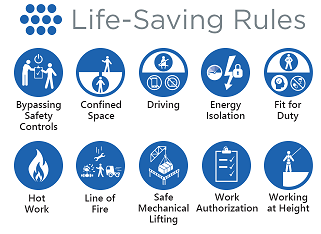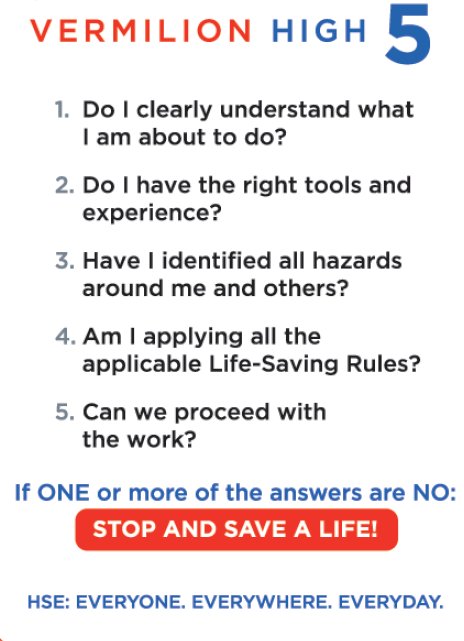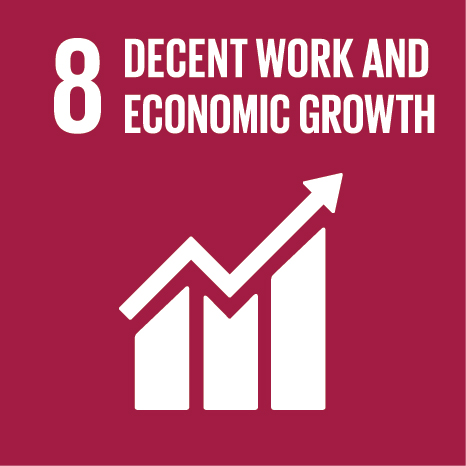Our Approach to Safety
At Vermilion, we are committed to our vision of HSE: Everyone. Everywhere. Everyday. We are focused on ensuring everyone who comes to our locations returns home safely every day.
In particular our Operational Risk Management Standard provides a consistent, systematic approach to integrating risk assessment (identification, analysis and evaluation), risk treatment (tolerability, mitigation and management action plans), risk acceptance, and risk monitoring and review into all parts of our business. This is supported by our Contractor Selection and Management Standard. This provides requirements for hiring and managing contractors and sub-contractors (contractors) to conduct work, deliver goods, or supplies services to Vermilion, including the minimum requirements to identify, evaluate and approve contractors, and describes the phases of the contracting lifecycle requirements using a risk-based approach, including pre-qualification, supervision and verification.
Our Corporate HSE Compliance Assurance Standard provides a set of audit and assessment requirements, including intended scope, frequency, objectives and stakeholders for each.
We have communication plans in place throughout our global locations, including outreach to our communities and nearby landowners. For example, our Corrib operation in Ireland includes online community emergency response information for both the Corrib Gas Onshore Pipeline and the Bellanaboy Bridge Gas Terminal.
We follow the globally accepted Incident Command System (ICS), which applies to all kinds of emergencies, large and small. It is applied consistently with local emergency responders and across each operating area, and provides a common organizational structure and communications strategy to aid the management of resources.
Level 1 ERP | Level 2 ERP | Level 3 ERP | Level 4 ERP |
|---|---|---|---|
Table top exercise – Includes discussion of various emergency scenarios, cross training of ICS roles and responsibilities.
| In-Country Operations-only Simulation – Includes the mobilization of business unit staff, first level of scenario role playing.
| Simulation includes Vermilion’s Corporate Command Team Activation. Corporate Command owns corrective action logs and improvement schedule. Role playing of all Vermilion personnel involved. | Simulation includes Vermilion’s Corporate Command Team Activation and external parties (other industry, emergency responders, government authorities, other external stakeholders).
|
The exercise was conducted over four continuous days across two locations 2,000 kilometres apart: Perth (base for Incident Command Teams and our own Australian office) and Karratha (base for Field Response Teams). It provided an excellent opportunity for government and industry to test their response readiness and cross jurisdictional coordination, and we were pleased to play our role.
Simulations and exercises are organized throughout the year to train our people and test the effectiveness of our emergency response plan (ERP) under various scenarios.
We also evaluate the effectiveness of every exercise and ERP that is conducted.
Level 1 ERP
In-Country Operations-only Simulation – Includes the mobilization of business unit staff, first level of scenario role playing.
Level 2 ERP
In-Country Operations-only Simulation – Includes the mobilization of business unit staff, first level of scenario role playing.
Level 3 ERP
Simulation includes Vermilion’s Corporate Command Team Activation. Corporate Command owns corrective action logs and improvement schedule. Role playing of all Vermilion personnel involved.
Level 4 ERP
Simulation includes Vermilion’s Corporate Command Team Activation and external parties (other industry, emergency responders, government authorities, other external stakeholders).
This is an evolution of our previous work on identifying and managing fatal risks, and incorporates strong management programs, including hazard identification and risk management, competency and risk-specfic training.
For example, we hold regular road safety training and awareness events in our business units, and we monitor proactive indicators of road safety in our fleet vehicles, including overall speed and hard braking events, in addition to outcome indicators such as incidents.

If the answer to any of the preceding five questions is no, all work must be stopped, the task reassessed using a hazard-risk-mitigation methodology, and all required actions implemented to ensure a safe workplace. Only once the answer to every question is yes may work start or reassume. We believe this simple personal safety awareness initiative tool can prevent many HSE incidents.
Tools such as these have been rolled out globally to our staff and vendors. They don’t replace any design, technical and administrative layers of protection that we already have in place, but are an additional layer of defence to achieve safe performance. They can also live beyond the work site: we encourage our staff to use the tools in our offices and everyday lives, increasing awareness of possible hazards that can impact safety.

Regulators in Ireland and Australia use a Safety Case approach. In Australia, for example, our Wandoo facilities have a Safety Case and Environment Plan that are assessed and accepted every 5 years by the Regulator, NOPSEMA to ensure:
- The identified hazards and potential impacts are suitable for the Wandoo Facilities
- Hazards are assessed and managed to as low as reasonably practical, and
- A management system is in place to support and monitor implementation of hazard controls on a continual basis.
The Safety Case is focused on the prevention of major accident events. Vermilion is required to identify, assess and manage major accident events through a series of formal safety assessments, including flammable hazards analysis, explosion risk assessment, and Escape, Temporary Refuge, Evacuation and Recovery Analysis.
The Environment Plan addresses the environmental impact from operations, well construction and oil spill response and includes:
- Wandoo Facility Environment Plan
- Wandoo Well Construction Environment Plan
- Wandoo Field Oil Spill Contingency Plan
The Safety Case and Environment Plans require engagement with relevant stakeholders, including our workforce and those that may be directly impacted by our day-to-day activities.
We are also using drones to make visual inspections more efficient and safer. Equipped with high-resolution cameras and multiple sensors, they are replacing time-consuming and potentially hazardous manual inspections. Some of our staff are now certified drone pilots, providing our teams with real-time data for decisions on asset management, site planning, environmental monitoring and maintenance.
In Canada, we have installed approximately 800 “WatchDog” devices: hardware devices that attach to a wellhead and connect sensors, a camera, solar batteries and a modem to a cloud-based web platform. In addition to providing remote monitoring for a well’s performance, these devices can detect leaks and other events, flagging them for our staff who can respond and remedy quickly and often remotely. This reduces potential spill volumes, and also greatly reduces driving time for our operators, who would otherwise have to visit the well sites, thus also making their work safer.
To adequately assess safety performance, we take a balanced approach by measuring outcomes such as recordable injuries. However, such lagging indicators are reactive in nature, can be a poor gauge of prevention and sometimes may lead to falsely interpreting low injury rates as an absence of risks in the workplace. We therefore prefer to concentrate on more proactive measures of performance.
Our leading and lagging KPIs are published monthly on our intranet to allow staff to follow their progress on hazard awareness and risk management. The KPIs also contribute to our corporate performance scorecard, thereby influencing short and long-term incentive compensation for all employees and executives. As part of our overall safety management processes, we fully investigate all incidents and near misses, and implement corrective actions, guided by our Fair Culture policy. We also communicate lessons learned across our business units to continuously improve our performance.
External verifications include Equitable Origin’s EO100TM Standard for Responsible Energy Development, for our West Pembina sites in Alberta, the Business Working Responsibly Mark for our Ireland Business Unit, and the AFNOR “Committed” label in our France Business Unit (the latter two are based on ISO 26000).


